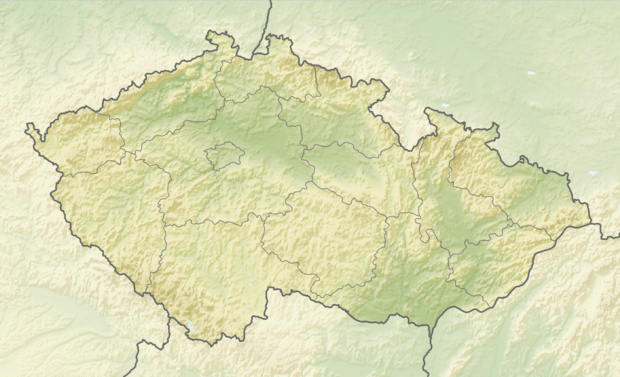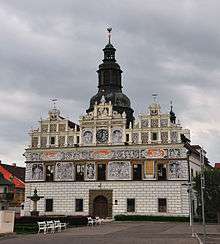Stříbro
Stříbro (Czech pronunciation: [ˈstr̝̊iːbro]; German: Mies) is a town in the Plzeň Region of the Czech Republic. It has about 7,700 inhabitants. The town features a Renaissance-era Stříbro Bridge.
Stříbro | |
|---|---|
Town | |
.jpg) Town centre | |
.svg.png) Flag _CoA_CZ.jpg) Coat of arms | |
 Stříbro Location in the Czech Republic | |
| Coordinates: 49°45′11″N 13°0′15″E | |
| Country | |
| Region | Plzeň |
| District | Tachov |
| First mentioned | 1183 |
| Parts | List
|
| Government | |
| • Mayor | Václav Votava (ČSSD) |
| Area | |
| • Total | 47.78 km2 (18.45 sq mi) |
| Elevation | 399 m (1,309 ft) |
| Population (2020-01-01[1]) | |
| • Total | 7,738 |
| • Density | 160/km2 (420/sq mi) |
| Time zone | UTC+1 (CET) |
| • Summer (DST) | UTC+2 (CEST) |
| Postal code | 349 01 |
| Website | www |
Stříbro is also the seat of the Municipality with Extended Competence.
Etymology
The Czech name derives from silver (Czech: stříbro), which used to be mined there. The German name Mies comes from the name of the river Mies/Mže (Latin: Misa).
Geography
The mining town is located on the Mže river in the west of the historic Bohemia region, some 25 km (16 mi) to the west from the region capital of Plzeň.
History
According to the 16th century chronicler Wenceslaus Hajek, the mining settlement in the Duchy of Bohemia was founded by the Přemyslid duke Soběslav I in 1131. Located on an important trade route (Zlatá cesta, "Golden Road") from Prague to Nuremberg, it was first documented in 1183, when Duke Frederick and his consort Elizabeth of Hungary dedicated the first parish church to the Order of Malta. In 1243 King Wenceslaus I of Bohemia left the commandry to the Knights of the Cross with the Red Star. Mies received town privileges in 1263. The Czech name Stříbro is documented from the 14th century onwards.
During the Hussite Wars, the town was besieged by the troops of Jan Žižka in 1421, though it was not occupied until in 1427. Shortly afterwards, the Hussite forces under Prokop the Great could repel an attack by the Crusaders in the Battle of Mies. In 1541 the citizens turned Protestant. Silver mining was resumed under the Habsburg king Ferdinand I in 1554. Upon the Battle of White Mountain, the town was subdued to the measures of the Counter-Reformation.
Until 1918, Mies in Böhmen (previously Mies) was part of the Habsburg Monarchy and of the Cisleithanian ("Austrian") side after the Austro-Hungarian Compromise of 1867. It was the administrative centre of a district (Bezirk) with the same name, one of the 94 Bezirkshauptmannschaften in Bohemia.[2] From 1918, Stříbro belonged to Czechoslovakia. After World War II the remaining German population was expelled.
Notable people
- Jacob of Mies (1372–1429), reformer
- Vincent Houška (1766–1840), composer and musician
- Ernst Streeruwitz (1874–1952), officer, businessman and politician
Twin towns – sister cities




References
- "Population of Municipalities – 1 January 2020". Czech Statistical Office. 2020-04-30.
- Die postalischen Abstempelungen auf den österreichischen Postwertzeichen-Ausgaben 1867, 1883 und 1890, Wilhelm KLEIN, 1967
- "Partnerská města" (in Czech). Město Stříbro. Retrieved 2020-08-04.
External links
- Official website (in Czech)

